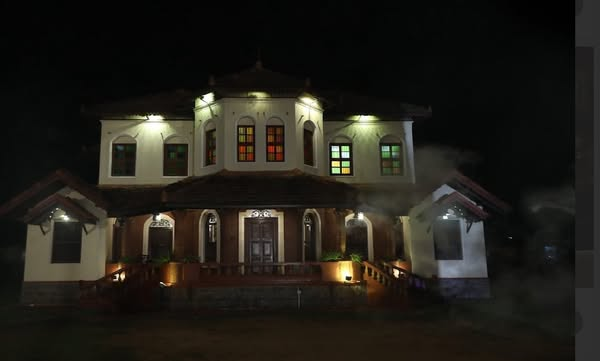Kamaro2 Movie Review: A Haunting Yet Human Tale

When we walked into the theater for Kamaro2, we carried a mix of anticipation and caution. Horror sequels often stumble, either by leaning too heavily on old tricks or by overcomplicating their narratives. Yet, from the very first scene, Kamaro2 proved that it wasn’t just a recycled tale—it was a carefully built experience that respected its roots while pushing the story forward.
The Story: Two Roads Converge at Kamarottu
The film opens in New Delhi, where we meet Sara, played with intense conviction by Priyanka Upendra. Sara searches for her missing sister, and her pursuit of truth leads her to the infamous Kamarottu house. The air grows thick with mystery as she arrives in the misty village, a place where the past clings to the walls like cobwebs.
At the same time, another story unfolds. Newlyweds Aarya (Swaminathan Anantharama) and Swathi (Rajini Baradwaj) move into their ancestral home in Kamarottu. Aarya throws himself into Ayurvedic research, but Swathi feels something stir in the shadows. Her unease intensifies when they encounter a young orphaned child whose very presence adds a deeper layer of tension. We sat forward in our seats as the two storylines slowly drew closer, every moment thick with dread.
The eventual meeting between Sara and the couple doesn’t feel forced. It feels inevitable, like pieces of a puzzle finally sliding into place. That convergence transforms the film from a series of eerie episodes into a single, tightly wound thriller.
Performances: Conviction Over Gimmicks
Priyanka Upendra owns the film. She portrays Sara not as a scream queen running from ghosts, but as a woman determined to find answers no matter the cost. Her grounded presence keeps the narrative believable, and we felt her resolve echo long after the credits rolled.
Swaminathan Anantharama and Rajini Baradwaj breathe life into Aarya and Swathi. Their chemistry feels natural; their contrasting attitudes—his rationalism versus her intuition—mirror the way audiences often approach horror films themselves. We related to Swathi’s quiet fear, and we understood Aarya’s refusal to acknowledge the supernatural. Both performances create a balance that the story thrives on.
Supporting actors like Ninasam Ashwath, Mahesh Raj, and Nagendra Urs round out the cast, each guarding secrets of the Kamarottu estate. Their characters deepen the mystery instead of distracting from it. Every time they appeared, we leaned in, eager for another piece of the haunted puzzle.
Direction and Craftsmanship
Director A. Paramesh doesn’t rush. He lingers on shadows, on empty corridors, on the stillness before a storm. That patience builds a slow-burning dread. We never felt bombarded by jump scares or cheap tricks. Instead, the film trusted its atmosphere to do the heavy lifting.
The cinematography by Prajwal Gowda wraps the story in mist and dim lantern light. Every frame feels soaked in unease. The sound design—subtle knocks, whispers in the background, doors creaking—didn’t just make us jump, it kept us tense throughout. A.T. Ravish’s score added layers of mood without overwhelming the narrative. We felt guided deeper into Kamarottu’s labyrinth with every note.
The editing, handled by Aryan Muktha Raj, respects the film’s deliberate pacing. At moments, it almost felt too slow, but then a sudden reveal or emotional exchange reminded us why the film chose to breathe rather than sprint.
Themes: More Than a Ghost Story
While Kamaro2 functions as a horror film, it also works as a human drama. Sara’s search for her sister resonates on an emotional level. Swathi’s compassion for the orphan child reminded us that even in haunted spaces, humanity finds a way to shine. The supernatural elements reflect deeper fears—loss, secrecy, betrayal. The film tells us that ghosts don’t always exist in shadows; sometimes they live in the choices people make.
We also noticed subtle commentary on tradition and modernity. Aarya’s focus on Ayurvedic research contrasted against the backdrop of a house bound by spiritual curses. The film asks whether science and faith can coexist, and it doesn’t deliver easy answers.
Our Experience in the Theater
Sitting in the dark hall, we felt a constant pull between curiosity and dread. Some scenes chilled us—the silent stare of the orphan child, the sudden flicker of a candle in the abandoned prayer room, Sara’s trembling hand hovering over a half-open door. At other times, we felt warmth, especially in Swathi’s quiet determination to care for the boy despite her fear. The mix of human intimacy and supernatural suspense made the experience layered rather than monotonous.
Unlike many horror films that try to scare audiences every five minutes, Kamaro2 allowed us to sink into its world. That choice gave the scares more weight. When they arrived, they hit harder.
Audience Reaction
We listened as the crowd reacted. Gasps filled the hall during tense sequences, followed by laughter of relief. Some viewers whispered their theories during intermission, debating whether the film leaned toward supernatural horror or psychological suspense. After the final act, applause broke out—though mixed murmurs followed too. Some people praised the story’s maturity, while others complained that it lacked enough “pure horror.” That divide matched our own thoughts: Kamaro2 doesn’t cater to adrenaline junkies, it caters to those who appreciate storytelling.
Strengths and Weaknesses
Strengths
- Strong performances, especially from Priyanka Upendra.
- Atmosphere-first direction that avoids gimmicks.
- A layered narrative that balances horror and emotion.
- Technical finesse in sound, music, and cinematography.
Weaknesses
- Slow pacing in parts may test impatient viewers.
- Horror purists might find the scares too gentle.
- The climax resolves neatly, but some may want more ambiguity.
How It Fits in 2025 Cinema
In a year crowded with big-budget spectacles and action-heavy blockbusters, Kamaro2 stands out as a restrained, story-driven horror film. It doesn’t aim for box-office dominance, but it carves a niche among viewers looking for a different flavor. In the broader Kannada film landscape, which continues to diversify, Kamaro2 adds a respectable entry into the horror genre—a genre still underexplored with such care in regional cinema.
Final Verdict
When we walked out of the theater, we didn’t feel shaken to the core like after a gore-fest. Instead, we carried a thoughtful chill, the kind that lingers in the back of your mind when the lights go out at home. Kamaro2 doesn’t try to terrify you every minute; it tries to make you care, think, and then shiver.
If you crave non-stop screams, you may find it too slow. But if you want a haunting experience built on storytelling, atmosphere, and human emotion, Kamaro2 delivers. We left with respect for the craft and with the image of that haunted Kamarottu house etched in our memory.
Our Rating: 3.5/5
Kamaro2 proves that horror can whisper as effectively as it screams.













